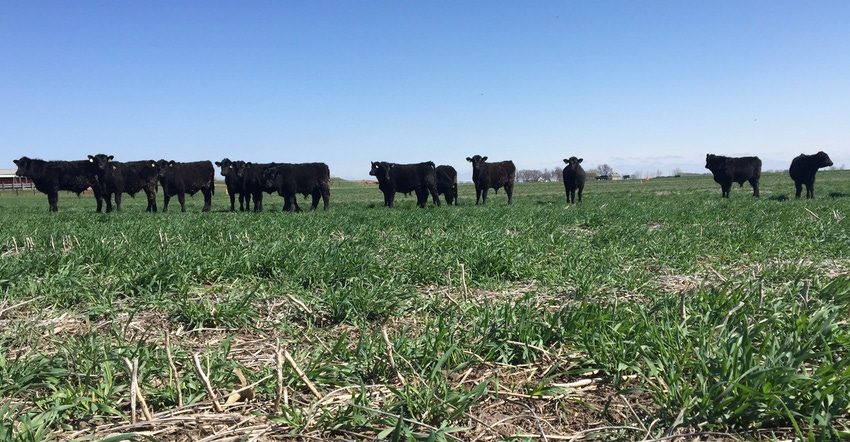December 16, 2020

With the drought this past growing season, some cattle producers may feel like their forage supply is a little tight. While there are ways to make your forage supply stretch further, an additional option to consider is integrating annual forages into your rotation to provide additional short-term forage or perhaps extend the grazing season.
While annual forages provide known benefits such as reducing soil erosion, improving soil health and scavenging nutrients, there are questions about how to best integrate annuals into a rotation. At several research farms, Iowa State University is studying cool- and warm-season annual forages to develop best management practices, as well as collect data on what producers can expect for forage yield and feed quality. This article shares some best management practices and preliminary results from the study.
Species selection
Both cool-season and warm-season annuals can be used for forage. When selecting what species to plant, it’s important to select based on yield potential, regrowth potential, feed value, seasonal forage needs, potentially toxic or anti-quality components, and suitability for hay grazing, or silage.
You can plant a single species, a mix of cool-season species, or a mix of warm-season species. Avoid mixing cool- and warm-season species together.
Cool-season annual forages, such as oats, brassicas, rye, wheat and triticale, are typically planted in fall, but can be planted in spring. Some species overwinter, while others winterkill. They can be grazed in fall or spring, or mechanically harvested.
Warm-season annuals, which include species like sudangrass, millets or sorghum-sudangrass, are typically planted in late spring or early summer. Warm-season annuals can be grazed and provide a rest period for pastures during the summer slump, or they can be mechanically harvested. Many species allow for two or three cuttings, or grazings per summer.
Note that prussic acid poisoning can be a concern with sorghum, sorghum-sudangrass and sudangrass in summer on regrowth of plants or tillers that have been grazed short, during a severe drought or with a frost in fall.
Additionally, when selecting species, it’s important to double-check pesticide labels for any crop rotation, grazing or haying restrictions on products previously applied to the field, as well as any products you plan to apply. A good resource to check pesticide labels is cdms.net.
Soil fertility management
Proper soil fertility is important to maximize forage productivity. If you haven’t done so recently, take a soil test to determine soil nutrient levels and needs for phosphorus, potassium and lime. A good resource to help interpret soil test results and make fertilizer recommendations is ISU publication PM1688, A General Guide for Crop Nutrient and Limestone Recommendations in Iowa.
If you are planning on mechanically harvesting the forage, it’s important to account for what crop nutrients will be removed from the field. Forages tend to have high phosphorus and potassium removal rates. For instance, sorghum sudangrass removes 11 pounds of P2O5 per ton and 33 pounds of K2O per ton. Refer to Table 2 in ISU publication PM1688 for crop removal rates.
Nitrogen can help boost productivity, particularly for grasses. If applying nitrogen to cool-season annuals, a rate of 40 to 60 pounds of nitrogen per acre can be applied in the spring at green-up. Nitrogen is often the most limiting nutrient for warm-season annuals. At planting, it is recommended to apply 50 to 60 pounds of nitrogen per acre. After the first grazing or cutting for harvest, additional nitrogen (another 40 to 50 pounds of nitrogen per acre) may be needed to help promote regrowth.
Grazing and harvesting
Cool-season annuals are ready for grazing when they pass the pluck test — pull on the plant, and if it doesn’t pull out of the ground, it is ready to be grazed. If grazing in the fall, and you wish to graze in the spring, be careful to not graze too short.
For warm-season annuals like forage sorghum, sudangrass or sorghum-sudangrass, these are typically ready for grazing when they reach 24 inches tall. Be careful to not graze or harvest too short, as that can be detrimental for regrowth. Ideally, you would like about a 10-inch stubble height.
With warm-season annuals, feed waste can be significant, so strip-grazing can help to reduce waste of these forages. This can be accomplished with a single electrified wire moved weekly or twice per week. If strip grazing, start with the section of field closest to the water source, and leave adequate forage residue for regrowth or protection from erosion. If you plan to mechanically harvest, it’s recommended to harvest warm-season annuals as silage or for baleage. Harvesting for dry hay is typically not recommended due to large, course stems that are often difficult to dry down.
Forage quality
Annual forages can be a high-quality forage source. The table accompanying this article provides a forage quality summary during the 2020 growing season for annual forages included in the ISU study.

For spring-calving cows, nutritional requirements are highest at 45 to 60 days post calving, which often aligns with the time frame of grazing cool-season annuals. In general, early lactation requirements are 58% total digestible nutrients (TDN) and 13% crude protein (CP), so these cool-season annuals are sufficient to meet cow requirements. It is often recommended to provide some supplementation to optimize performance when grazing cover crops due to their high moisture content.
Warm-season annuals are often grazed or harvested before the plant reaches the reproductive stage and therefore are of high nutrient value, exceeding requirements of beef cows.
For answers to your questions on using annual forages, contact your ISU Extension field agronomist or beef field specialist. More information is available at ISU Extension.
Vittetoe is the ISU Extension field agronomist for east-central Iowa. Email [email protected]. Special thanks to ISU Extension beef specialists Erika Lundy, Denise Schwab, Chris Clark, Beth Reynolds and field agronomist Aaron Saeugling for their assistance on this article.
About the Author(s)
You May Also Like




